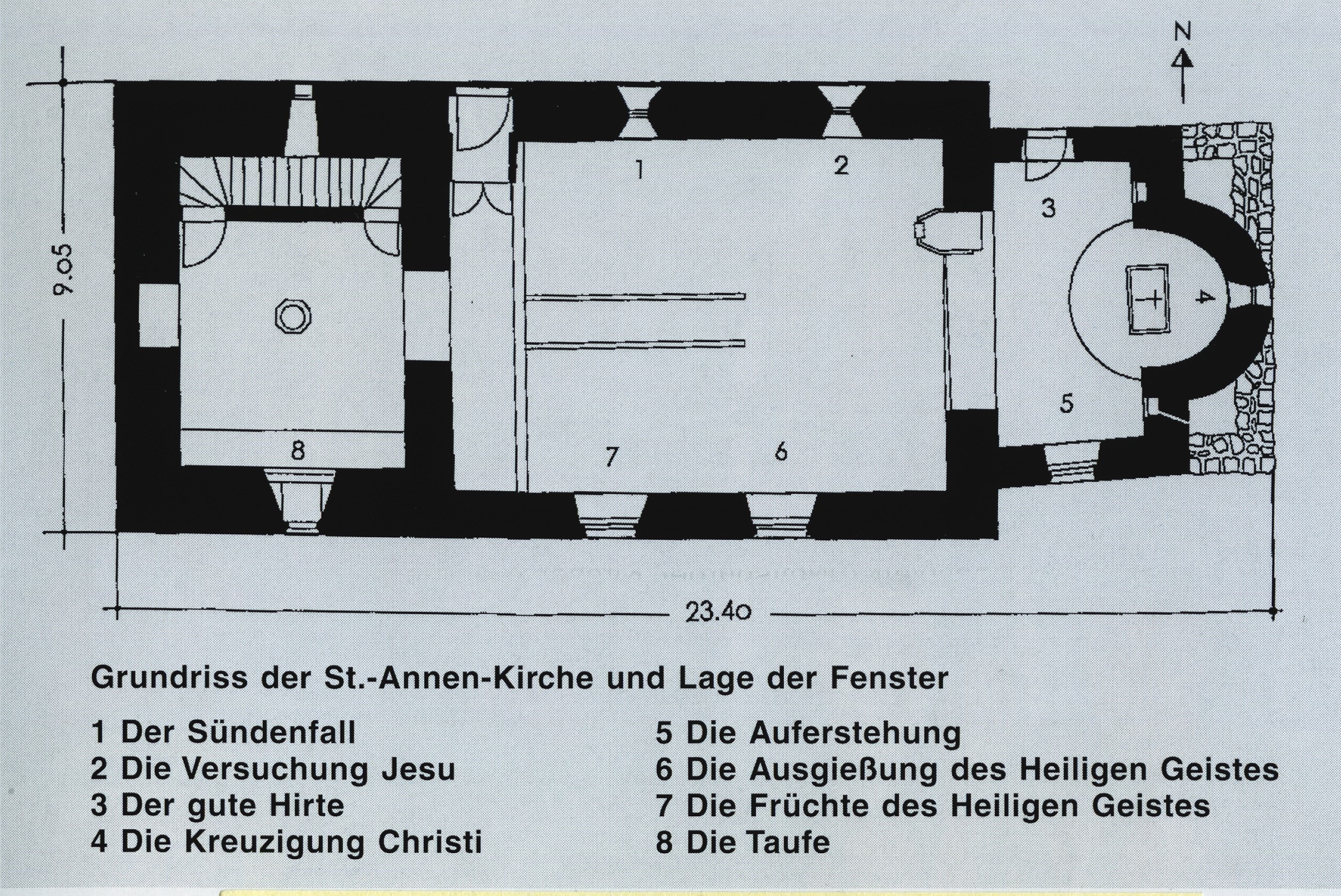St. Anne's Church is one of the earliest mentioned buildings in Wolfsburg. An early predecessor building is already mentioned for the year 971. The Bishop of Halberstadt had a "wooden church with a wooden monastery" built for nuns and a prior on the site of today's St. Anne's Church. Over time, the number of nuns in the convent decreased, while the buildings fell into disrepair. Eventually, the convent was dissolved.
The majority of the building stock that still exists today probably dates back to the second third of the 13th century. The building style of St. Anne's Church was originally Romanesque. However, Gothic to High Medieval influences were also added in the course of subsequent remodeling. Velpk sandstone as well as fieldstone and sandstone from nearby quarries were used as building materials for the stone church. The church was initially equipped with one bell. A second bell was added in 1423.
The document "Acta Wluesborch" from June 17, 1302 contains a further reference to the church, in which the responsible priest Hildebrand (Hildebrandus, plebanus de heslinghe) is mentioned. The document also makes clear the close connection with the history of Wolfsburg Castle and the Lords of Bartensleben. The parish belonged to the territory of the Bishop of Halberstadt. The district of the parish was later extended. From 1311, the right to levy the "tithe" in the parish was transferred to the lords of the castle.
In 1559, the Archbishop of Magdeburg issued the Lords of Bartensleben a feudal charter with the associated rights and possessions, which also included St. Anne's Church. From 1558, Valentinus Spengler, who had trained in Wittenberg, looked after the parishes of St. Marien (Old Wolfsburg) and St. Annen.
During the Thirty Years' War (1618-1648), the town and St. Anne's Church were repeatedly plundered and partially destroyed by marauding troops.
After the death of the last Lord of Bartensleben, the patronage passed to the Counts of Schulenburg in 1742.
Between 1867 and 1868, Countess Anna Luise Charlotte von der Schulenburg, the sister of the patron saint of St. Anne's Church, had extensive reconstruction and restoration work carried out. Boulders, ashlars of red Velpk sandstone and limestone from the quarries on Klieversberg were used to build a new, large portal into the massive west tower. In the chancel, niches and the remains of a Gothic altar and the vaulted apse, a landmark of the Romanesque church, were restored.
In 1938, with the founding of the "City of the KdF-Wagen near Fallersleben", the "Gesellschaft zur Vorbereitung des Deutschen Volkswagens mbH" acquired the patronage obligations. This is followed by a change from the church province of Saxony to the Evangelical Lutheran Church of Hanover.
There were only two church buildings in the whole of Wolfsburg: St. Annen and St. Marien. Part of church life took place in emergency churches. The enormous influx of people made the construction of further churches essential.
Chronology
| 971 |
First documented mention of St. Anne's Church, predecessor building made of wood |
| 13th century | Construction of St. Anne's Church as a Romanesque hall church with a tower, nave, choir and apse made of quarry stone; the church is equipped with a bell |
| 1423 | A second bell is installed in the church tower |
| 1564 | First Lutheran general church visitation by the Archbishopric of Magdeburg |
| 1618 - 1648 | During the Thirty Years' War, the church was looted, pillaged and partially destroyed, necessitating repair work. |
| 1661 | Reconstruction of the church completed |
| 1867 - 1868 | Countess Anna Louise Charlotte von der Schulenburg has St. Anne's Church extensively renovated and donates a kindergarten and a school for the children of the servants of the Wolfsburg estate and the Rothehof. |
| 1959 - 1962 | Last restoration of St. Anne's Church under the direction of Prof. Dr. Frank D. Hemmer. Installation of the first six stained glass windows, thematically determined by Pastor Erich Bammel |
Church windows in St. Annen
When St. Anne's Church in Wolfsburg-Hesslingen was redesigned between 1959 and 1961, Pastor Erich Bammel (1913-1985), who also established the deaconry in Wolfsburg, specified the design of six windows. The artist Professor Wilhelm Rupprecht (1886-1963) from Fürstenfeldbruck was responsible for their practical implementation.
The windows are located on the north, east and south sides of the church (see sketch). The depictions are based on biblical themes: the fall of Adam and Eve (no. 1), the temptation (no. 2), the crucifixion (no. 4) and the resurrection of Jesus (no. 5), the outpouring of the Holy Spirit - the miracle of Pentecost (no. 6) and the fruits of the Holy Spirit (no. 7).
The works of mercy, which illustrate the fruits of the Holy Spirit (No. 7), have become a popular theme in pictorial representation. They can be seen above church doors and on altarpieces, but also in stained glass windows. This is how Rupprecht did it: Two deaconesses can be seen in the lower window field, standing back to back, feeding the hungry and watering the thirsty. Two other deaconesses, also standing back to back in the middle section of the picture, are sheltering strangers and clothing the naked. In the arched field at the top, two deaconesses can be seen at the edge of the picture, framing the figures in the scenes between them. One is nursing the sick while the other comforts a prisoner.
Taken together, all three parts of the window form a holistic picture: due to their positioning in the overall structure, the six deaconesses form the shape of a tree with a trunk and crown. The message is clear: as under a tree, those in need of help find protection in the diaconia. Accordingly, this window is also known as the "deaconess window".
Two other windows, however, were not conceived by Pastor Bammel. One of them - The Good Shepherd - was created according to a design by the sculptor H. Lammers and finally installed in 1979 (no. 3). The window in the room with the baptismal font - The Baptism - was designed by G. Hausmann and fits in thematically with the function (No. 8).
Text by Werner Scholz (edited by Daniel Nieswand)

